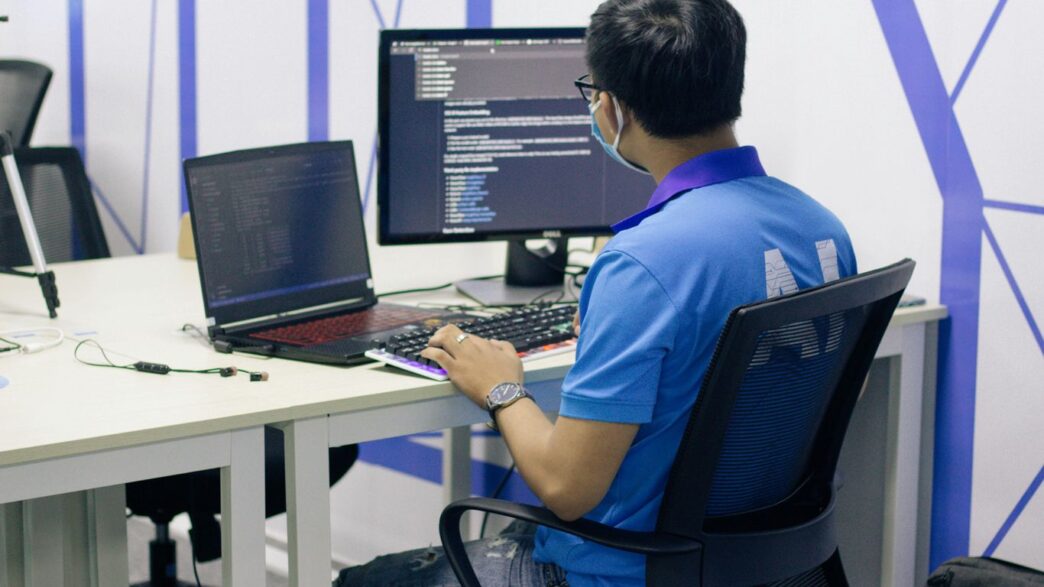The Ascendance of Artificial Intelligence in Software Testing
It feels like just yesterday we were talking about how automation was going to change everything in software testing. And it did, for sure. But now? AI is really shaking things up, and it’s not just a little shake, it’s more like a full-on earthquake. Companies are pouring money into AI for quality assurance – like, 73% of them are planning to use AI more in 2025, according to one report. The whole AI in testing market is expected to jump from about a billion dollars to almost four billion by 2032. That’s a huge jump, right? It means AI isn’t just a fancy add-on anymore; it’s becoming a core part of how we test software.
AI-Driven Automation for Enhanced Efficiency
So, what does this AI boom actually mean for testing? For starters, it’s making automation way smarter. Think about those test scripts that always break when something tiny changes. AI can help fix those on its own, which saves a ton of time and headaches. It’s also helping us find bugs earlier. Instead of waiting for tests to run and then finding issues, AI can look at patterns and predict where problems might pop up before they even happen. This means we can get software out the door faster without sacrificing quality. It’s like having a super-powered assistant who can spot trouble spots before you even get there.
Predictive Analytics for Proactive Defect Detection
This is where AI really shines. Predictive analytics uses all the data we have – past bugs, code changes, user behavior – to guess where new bugs are likely to show up. It’s not magic, but it’s pretty close. By focusing testing efforts on these high-risk areas, teams can catch more defects with less effort. This proactive approach is a big deal because fixing bugs later in the development cycle is way more expensive and time-consuming than catching them early. It helps teams be more strategic about their testing, rather than just running through a checklist.
Self-Healing Test Scripts to Reduce Maintenance Overhead
Anyone who’s done test automation knows that maintaining all those scripts can be a real pain. Every time the application changes, you might have to go back and update your tests. AI is changing that with ‘self-healing’ scripts. When a test fails because of a minor change in the application’s interface, the AI can figure out what changed and update the script automatically. This drastically cuts down on the time testers spend on maintenance, freeing them up to do more complex testing or explore new areas. It’s a game-changer for keeping automation suites up-to-date without constant manual intervention.
Embracing Continuous Quality Through Shift-Left and Shift-Right
Okay, so we’ve talked a bit about AI, but what about making sure our software is good all the time, not just at the end? That’s where the whole "shift-left" and "shift-right" idea comes in. It’s not just a buzzword; it’s about building quality right into the process from the very start and then keeping an eye on it even after it’s out in the wild.
Integrating Testing Early in the Development Lifecycle
Think about it: finding a problem when you’re just sketching out an idea is way easier and cheaper than trying to fix it when the product is already in customers’ hands. That’s the core of shift-left. It means we’re not waiting until the last minute to test. We’re bringing testing activities much earlier. This could involve developers writing more unit tests as they code, using tools that check code for potential issues automatically, or even having testers look at requirements and designs before any code is written. The goal is to catch bugs when they’re small and simple to fix.
Here’s a quick look at what that means:
- Requirements Review: Testers and developers collaborate to make sure the requirements are clear and testable from day one.
- Developer Testing: Unit tests, integration tests, and static code analysis become standard practice for developers.
- Early Automation: Automating tests for core functionalities as soon as they are developed, rather than waiting for the entire feature.
Leveraging Production Feedback for Continuous Improvement
Now, shift-left is great, but it’s only half the story. What happens after the software is released? That’s where shift-right comes in. This is all about using what happens in the real world – with actual users – to make the software better. It’s like getting feedback from your customers and using it to improve your product.
This can involve a few different things:
- Monitoring Production: Keeping an eye on how the software is performing in the live environment. Are there errors? Is it slow?
- User Feedback: Actively collecting comments and bug reports from users.
- A/B Testing: Releasing different versions of a feature to small groups of users to see which one performs better.
The Synergy of Shift-Left and Shift-Right for a Complete Quality Loop
When you put shift-left and shift-right together, you get a really solid loop for quality. You’re preventing problems early on, and then you’re learning from how the software is actually used to keep making it better. It’s not just about finding bugs anymore; it’s about building software that’s reliable, performs well, and actually meets user needs over time. This combined approach helps us release software faster, with more confidence, and keeps it running smoothly long after launch. It’s a much smarter way to think about quality, really.
Low-Code/No-Code Platforms Revolutionizing Test Automation

The way we build software has changed a lot, and testing is catching up. You know how those low-code/no-code tools made it easier for people to build apps without being expert coders? Well, the same thing is happening in software testing. It’s pretty neat, actually.
Empowering Testers with Minimal Coding Expertise
Think about it: not everyone on a testing team is a coding wizard. That’s totally fine! Low-code/no-code (LC/NC) platforms let people create automated tests using visual tools, like drag-and-drop interfaces. This means testers who aren’t deep into programming can jump in and build tests. It’s like giving them a toolkit that doesn’t require a degree in computer science. This opens the door for more people to contribute to test automation, which is a big deal.
Accelerating Test Development and Maintenance
Building automated tests used to take ages. With LC/NC tools, you can whip up tests much faster. Because they use visual builders, you can often create a test in a fraction of the time it would take to write the code from scratch. And when it’s time to update those tests? That’s usually quicker too. If the application changes, you can often just tweak the visual flow of the test instead of rewriting lines of code. Some reports suggest this can cut down test development time by as much as 40%.
Expanding Test Ownership and Cross-Functional Collaboration
When testing becomes more accessible, it doesn’t just stay with the dedicated QA folks. Business analysts, product owners, and even developers can get more involved in creating and running tests. This shared responsibility means everyone has a better handle on the quality of the software. It helps break down those old silos between teams and gets everyone working together more smoothly. This kind of collaboration is really important for getting good software out the door quickly.
Hyperautomation: Automating the Entire Testing Lifecycle
End-to-End Automation from Planning to Reporting
Okay, so we’ve talked about AI and low-code, but what if we could take that a step further? That’s where hyperautomation comes in. Think of it as automating not just parts of testing, but the whole darn thing. We’re talking about everything from figuring out what tests we even need, to designing them, getting the right data, and then, of course, reporting on what we found. It’s about using AI, machine learning, and other smart tech to make the entire testing process run itself. This means less manual work, which, let’s be honest, is usually the slowest part. The goal here is to get software out the door faster and with fewer hiccups.
Smarter Decision-Making with Real-Time Analytics
One of the coolest things about hyperautomation is the data. It’s constantly crunching numbers from test runs, giving us insights as things are happening. No more waiting around for reports that are already old news. This real-time info helps teams make better choices, like where to focus their efforts or if a particular feature is causing more trouble than it’s worth. It’s like having a crystal ball for your software quality. We can spot potential problems before they even become real issues, which is a massive win.
Seamless Integration into CI/CD Pipelines
This is where hyperautomation really shines for modern development. It’s designed to fit right into those continuous integration and continuous delivery (CI/CD) pipelines we hear so much about. By automating testing within these pipelines, we can catch bugs and issues much earlier. This makes releases quicker and more reliable. It’s about making sure quality checks are just as automated and fast as the code deployments themselves. When testing is a smooth, automated part of the pipeline, we can push out updates more often and with a lot more confidence.
The Rise of Autonomous Testing Platforms
Beyond Automation: Intelligent and Adaptive Testing
So, we’ve talked a lot about automation, right? For a while there, it felt like the ultimate goal. Continuous automation testing platforms have been great, really helping us speed things up and cover more ground. But let’s be honest, hitting those super high automation percentages has been a struggle. And now, with AI writing code and applications doing their own AI thing, the old ways just aren’t cutting it anymore. We need something smarter, something that can actually keep up.
That’s where autonomous testing platforms come in. Think of them as the next level up. They’re not just about running tests automatically; they’re built with AI from the ground up. This means they can actually learn, adapt, and make decisions on their own. It’s like having a super-smart assistant that understands the complexities of AI-driven development, which is becoming more common every day. These platforms are designed to handle the new challenges that pop up when AI is involved in creating software, like when AI generates text that sounds right but is actually wrong.
Tester TuringBots Augmenting Human Capabilities
What’s really cool about these new platforms are what some folks are calling ‘Tester TuringBots.’ These aren’t just scripts; they’re advanced AI agents. Their job is to work alongside human testers, making us more productive and effective. They can handle bigger workloads, test more complex code, and deal with the weird quirks that AI applications sometimes have. It’s not about replacing testers, but about giving us better tools to do our jobs, especially when dealing with the unpredictable nature of AI.
Addressing the Complexities of AI-Driven Development
Developing software with AI is a whole new ballgame. Code can be generated at lightning speed, and AI applications can produce outputs that are hard to predict. Autonomous testing platforms are built to tackle this. They can:
- Analyze changes in code to figure out what needs re-testing.
- Use natural language to understand test requirements, making things more accessible.
- Create and manage AI agents that perform specific testing tasks.
- Monitor test runs and provide insights into quality, including potential AI biases or inaccuracies.
This shift is happening because the pace of development is so fast, and the tools we’re using are getting smarter. Autonomous testing is the logical next step to make sure our software is not just functional, but also reliable and secure in this new AI-powered world.
Prioritizing Security and Ethical AI in Testing

Okay, so AI is doing some pretty amazing things in software testing, right? It’s making things faster and catching bugs we might have missed. But with all this power comes a big responsibility. We can’t just let AI run wild without thinking about the consequences. That’s where focusing on security and making sure our AI is ethical comes in. It’s not just a nice-to-have anymore; it’s becoming a must-have.
Integrating Security Testing Throughout the Development Process
Remember when security was kind of an afterthought, something you tacked on at the end? Yeah, that doesn’t really fly anymore. With software getting more complex and threats evolving constantly, we need to bake security into every step. Think of it like building a house – you wouldn’t wait until the roof is on to check if the foundation is solid. We’re talking about testing for vulnerabilities from the moment the first line of code is written, all the way through to deployment and beyond.
- Early Vulnerability Detection: Catching security flaws early saves a ton of time and money. It’s way easier to fix a problem when it’s just a small issue, not a massive security breach.
- Automated Security Checks: We can use tools to automatically scan code for common security weaknesses. This frees up our human testers to focus on more complex security challenges.
- Continuous Monitoring: Once the software is out there, we need to keep an eye on it. This means setting up systems that constantly monitor for suspicious activity and alert us to any potential problems.
Ensuring Fairness, Transparency, and Accountability in AI Systems
This is a big one, especially with AI. AI systems learn from data, and if that data has biases, the AI will too. That can lead to unfair or discriminatory outcomes, which is obviously not good. We need to be really careful about this.
- Bias Detection and Mitigation: We need ways to check if our AI models are treating everyone fairly. If we find bias, we need to have strategies to fix it, like using more balanced data or adjusting the AI’s algorithms.
- Explainable AI (XAI): Sometimes, AI can feel like a black box – it gives an answer, but we don’t know how it got there. XAI aims to make AI decisions more understandable. This helps us trust the AI and also figure out what went wrong if something does go awry.
- Clear Accountability: When an AI makes a mistake, who’s responsible? We need clear lines of responsibility. This means documenting how the AI works, who developed it, and what its limitations are.
Ethical Testing Tools for Responsible AI Solutions
To actually do all of the above, we need the right tools. The market is starting to catch up, offering solutions that help us test AI systems with ethics in mind. These tools aren’t just about finding bugs; they’re about making sure the AI behaves responsibly.
- Fairness Auditing Tools: These help measure how fair an AI system is across different groups of people.
- Transparency Frameworks: These provide ways to visualize and understand the decision-making process of AI models.
- Robustness Testing: This checks how well an AI system holds up against unexpected inputs or adversarial attacks, which is a security concern but also an ethical one if it leads to unfair outcomes.
Wrapping Up: What’s Next for Software Testing?
So, we’ve looked at how software testing is changing, and it’s a lot. Things like AI are becoming a big deal, and we’re seeing more focus on testing earlier in the development process, not just at the end. It’s all about making things faster and better. To keep up, testers need to learn new skills, especially with AI and security. The world of testing isn’t standing still, and what’s coming next will probably involve even more advanced tech. It’s an exciting time to be in this field, with plenty of room for new ideas and ways of doing things.














